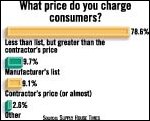
Consumer and metro-area magazines have lost share of the promotional budget; they're used by 28.6% of wholesalers this year vs. 32.4% in 1997.
Overall, a larger number of wholesalers are actively promoting their showrooms - only 21.3% of respondents say they have no promotion budget, vs. 37.7% in 1997. The down side is that they are spending less on promotions. About 12% more wholesalers today say their promotional budget is less than $10,000 compared with 1997. The percentage of wholesalers who spend $26,000 or more is 10.5% less than the percentage who said they spent $30,000 or more in the 1997 survey.
Part of the reason may be that manufacturers are spending fewer co-op advertising dollars today, according to the survey. Nearly a third of respondents say manufacturers contribute less than $3,000; 14.3% made that claim in 1997. Those who get $40,000 or more has dropped by more than half to 10.2% of wholesalers compared with 24.7% in 1997.

Selling to consumers
Despite the growth of the home center as a competitive challenge (see Part 1 in the April 2000 issue), a larger percentage of wholesalers today say they do not sell direct to consumers: 14.4% vs. 11% in 1997. Of those who do sell to consumers, a larger percentage of wholesalers do not offer a rebate to the plumber: 29.2% do not offer a rebate compared with 20.7% in 1997.Typical gross margins on showroom sales to consumers are shown in Fig. 1, which lists the percentages of wholesalers from both the 2000 and 1997 showroom surveys who revealed their gross margins. Wholesalers that reported a 36% to 40% gross margin dropped from 28.1% in 1997 to 19.4% in 2000.
Fig. 1 -- Percentage of respondents
Gross margin to consumers -- 30% and under: 39.6% (2000 survey) and 33.6% (1997 survey)
Gross margin to consumers -- 31% to 35%: 26.1% (2000 survey) and 25.8% (1997 survey)
Gross margin to consumers -- 36% to 40%: 19.4% (2000 survey) and 28.1% (1997 survey)

Pricing and costs
Wholesalers may be trying to boost margins by displaying more high-end product and adding product categories in their showrooms. More wholesalers this year say they are targeting luxury price points with their showroom mix: 39% vs. 31.9% in 1997.Wholesalers also are selling products such as water-treatment equipment/dispensers, spas and multihead showers and non-plumbing product. Tile is making a comeback. This year 15.7% of respondents say they carry tile, compared with 8.6% in 1997 and 15% in 1994.
Vendors remain the source of choice for up-to-date product information, according to 83.6% of wholesalers surveyed. The other options - trade shows and trade magazines - are cited as the primary source of product information by 8.2% and 7.7%, respectively, of survey respondents.
Home centers apparently also haven't had much effect on wholesalers displaying their prices in their showrooms. The 2000 survey finds that 59.1% do not display prices, compared with 54.3% in 1997. Among those who display prices, 26.5% show manufacturer's list, vs. 43.4% in 1997; and 6.6% display a price at or near the contractor's price, compared with 4.8% three years ago.
Where home-center competition may be having an impact is in the trend toward longer showroom hours, which is explored in more detail in this year's survey compared with past years. More showrooms are open Sundays: 3.9% vs. 1.6% in 1997; and more are open evenings, 32% vs. 30.6%. Asked how many evenings the showrooms are open, 59.6% of wholesalers say one night, 19.1% say two nights and 10.6% say five nights.
Computer-aided design is being offered as a service in 21.9% of wholesaler showrooms vs. 18.6% in 1997. Credit card transactions are conducted by 91% of wholesalers compared with 89.6% in 1997.
Of survey participants who estimate showroom operating costs as a percentage of total showroom sales, nearly a third (32%) report operating costs at 10% to 19% of total showroom sales. Nearly another third (30%) claim showroom operating costs of 25% and higher of sales. Less than 10% in operating costs is claimed by 21% of respondents; and 17% of those surveyed estimate their operating costs at 20% to 24%.
The average percentage contribution of plumbing contractors to showroom sales is 31.05%, respondents say. Consumers who come in on their own represent on average 19.27% in contribution to sales; consumers referred by contractors or others, 15.9%; builders, 13.14%; remodeling contractors, 12.55%; professional interior designers, 3.68%; kitchen and bath dealers, 2.54%; and other, 1.87%, according to survey respondents. The percentages have changed slightly since the 1997 survey; the ranking remains the same.

Showroom staffing
Fewer wholesalers have showroom managers, but those who do pay them a higher salary. In 2000, 50.6% of wholesalers say they have a showroom manager compared with 59.6% of respondents in 1997.The percentage of wholesalers who pay showroom managers $40,000 or more per year has leaped to 41.4% this year from 28.4% in 1997.
The average annual compensation for full-time showroom salespeople also has undergone some changes. The percentage of respondents who pay $30,000 and higher has dropped 9.4% since 1997; and 14.6% more of 2000 respondents pay $23,000 to $29,999, compared with those who paid $22,000 to $29,000 in 1997.
Equal numbers of wholesalers are training their showroom salespeople at vendor schools and by formal in-house training: 48.6%. Trade shows and workshops are used by 40.5% of wholesalers to train their showroom salespeople. Design schools are used for training by 15% vs. 12.4% in 1997.
Plumbing industry experience is still the single most important characteristic sought in a showroom salesperson, a pattern that has held true since the 1990 survey.
Other survey results are reported in the charts and graphs.
